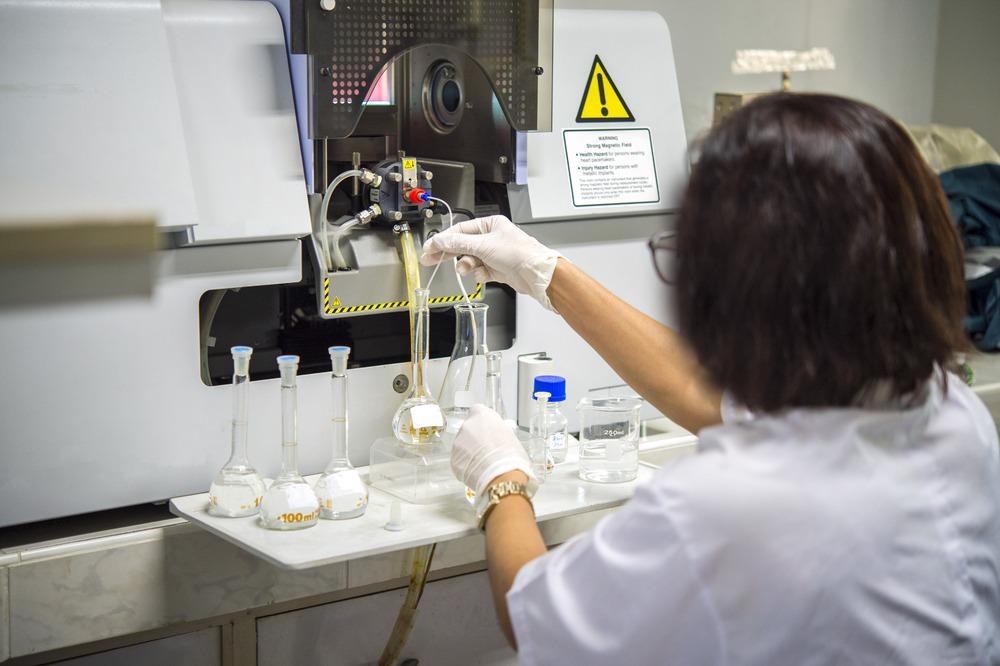
Image Credit: Rabbitmindphoto/Shutterstock.com
Spectroscopy is the scientific field dedicated to studying the relationships between matter and radiation. A form of non-destructive testing, spectroscopy is widely applied in many science and industry areas to understand various specimens' molecular make-up. This article takes a look at how spectroscopy is used in forensic science.
What is Spectroscopy?
The famous English scientist Sir Isaac Newton first used the word “spectrum” to refer to the array of colors in a rainbow. Although white light’s tendency to split into multiple colors when directed through a glass prism has been studied since Roman times, Newton is generally regarded as the father of modern spectroscopy.
The way we see these colors results from how electromagnetic radiation (waves of light) interacts with gaseous matter (water droplets in the atmosphere). Studying these spectra reveals essential information about the matter that the light passes through.
A century after Newton lived, Bavarian physicist Joseph von Fraunhofer took spectroscopy experimentation another step forward. He replaced the glass prism with a diffraction grating – a kind of screen through which light is diffracted and split into multiple beams traveling in different directions.
Fraunhofer’s improvement on the prism as a dispersion technique enabled electromagnetic spectra to be measured and studied. This is because his diffraction grating cast dispersed light onto a background board. He learned that the dispersion of colors on the board revealed information about the light source and matter that it was passing through.
Through spectroscopic inquiry, scientists learned that all materials have a unique spectral “fingerprint”. The same spectral pattern will always be revealed when the same source of electromagnetic radiation is applied to the same material. This also means that it is possible to discover the molecular make-up of matter by merely passing light through it (or scattering it off it, or many other ways of interacting with matter).
Since Newton, equipment for diffracting electromagnetic radiation and recording and measuring the resulting spectra has become increasingly sophisticated. One among many notable successes of spectroscopy was in the discovery and later acceptance of the quantum mechanical theory, driven experimentally by Niels Bohr when he used spectroscopy to analyze and describe the hydrogen’s atomic structure.
How is Spectroscopy Used in Forensics?
Forensic science studies and analyzes potential evidence from crime scenes to reveal important information about a crime that may have taken place. It is essential not to damage or significantly alter this evidence, and so forensic scientists must use non-destructive testing (NDT) methods such as spectroscopy to perform their analysis.
Forensic scientists can use spectroscopy methods to reveal the chemical make-up of blood samples and other bodily fluids. Electromagnetic radiation (usually from precisely calibrated lasers) is applied to the fluid sample. The resulting patterns of discrete bands of colors can be compared to a molecular spectra library to reveal what molecules the sample contains.
The sample is not affected by spectroscopic analysis like this and can be studied again with different methods or to seek confirmation. Another benefit of forensic science is that spectroscopy can be used to understand samples’ molecular make-up without removing the sample from the crime scene. Forensic scientists can take spectroscopy equipment and perform the analysis required there and then, supporting law enforcement to progress their investigations quickly.
Spectroscopy applied to bodily fluids in this way can reveal information about drugs or other intoxicants present in the body, any hazardous or poisonous substances present in the blood, and even stress levels (cortisol levels).
Forensic science also makes use of spectroscopy in the analysis of seized drugs. It can accurately identify chemical ingredients and match them with other seizures, helping law enforcement link up separate crimes.
Because it is non-destructive and can be performed safely, spectroscopy can also be used to analyze potentially hazardous unknown substances. Suspicious or alarming powders, liquids, or even gases at crime scenes can be safely investigated with spectroscopy, which will enable forensic scientists to precisely identify what they contain.
These examples serve to illustrate the rich application of spectroscopy in forensic science. Spectroscopy methods can be applied with numerous materials, electromagnetic radiation sources, and potential interaction types. Therefore, its uses in forensic science are wide-ranging and varied.
References and Further Reading
Douglas Arvid Skoog, F James Holler, and Stanley R Crouch (2007) Principles of Instrumental Analysis. Belmont, Ca: Thomson-Brooks/Cole. ISBN 978-0-495-01201-6.
Iskandar, Velda. (2020) Spectroscopy in Forensic Science. [Online] AZO Life Sciences. Available at: https://www.azolifesciences.com/article/Spectroscopy-in-Forensic-Science.aspx
Robertson, Sally. (2019) Mass Spectroscopy as a Tool in Forensic Science. [Online] News Medical Life Sciences. Available at: https://www.news-medical.net/life-sciences/Mass-Spectrometry-as-a-Tool-in-Forensic-Science.aspx
Disclaimer: The views expressed here are those of the author expressed in their private capacity and do not necessarily represent the views of AZoM.com Limited T/A AZoNetwork the owner and operator of this website. This disclaimer forms part of the Terms and conditions of use of this website.